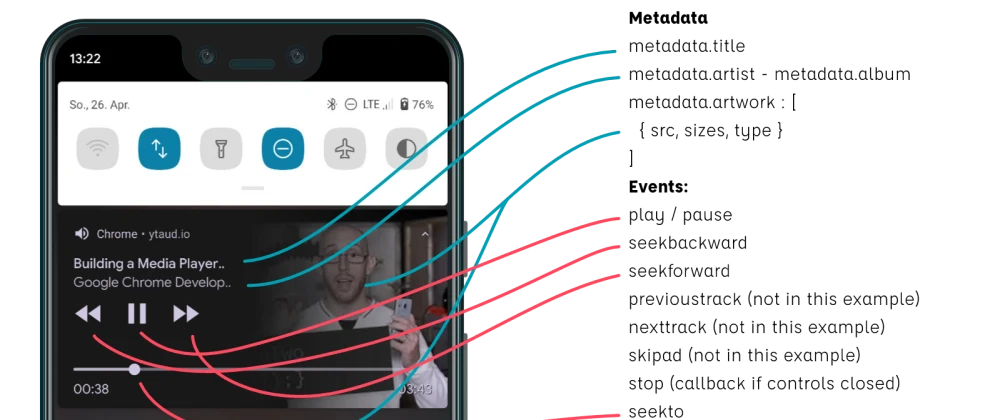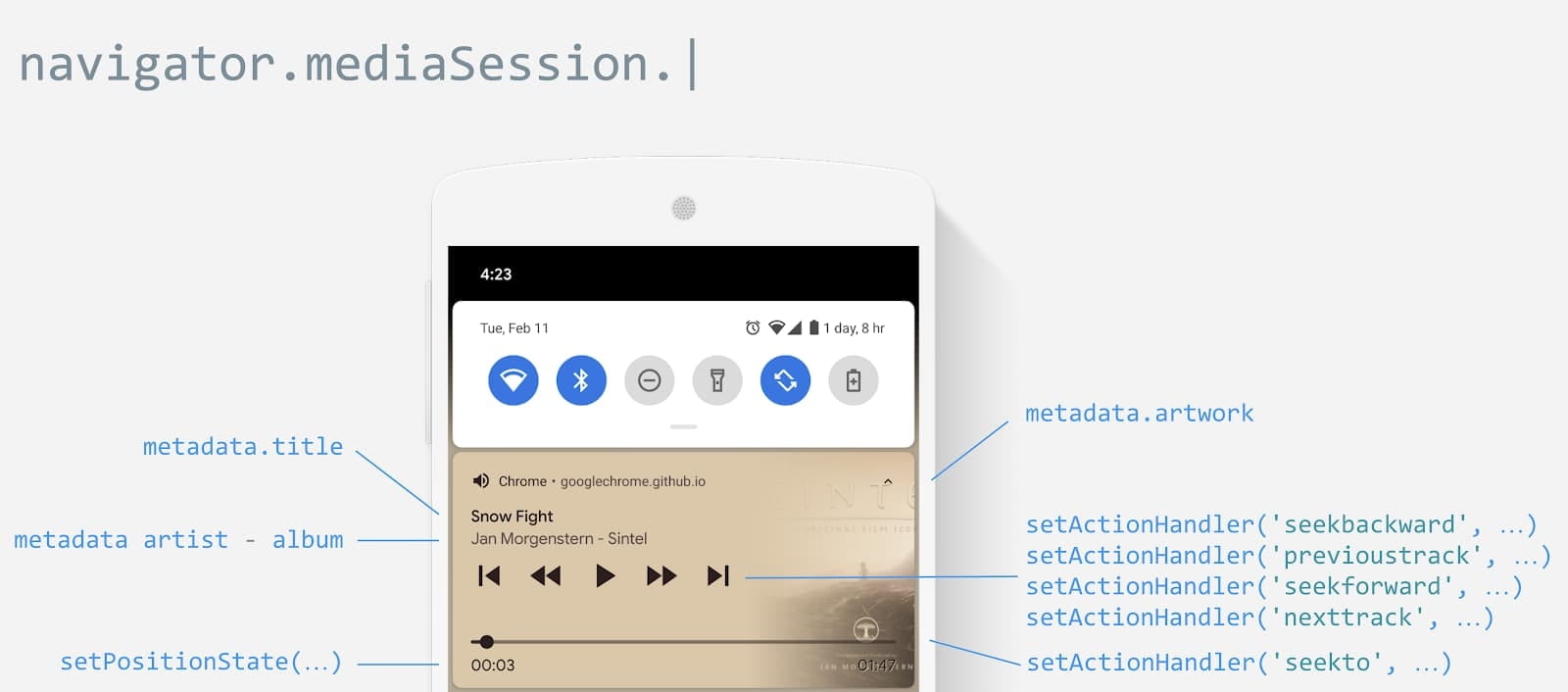I have an angular app with the Youtube IFrame API. When the website/pwa is used on an android device, and a Youtube video is playing, the app automatically creates a notification in the android notification tray, allowing you to see what video is currently playing.
I created my own playlist-controller, so I'm not using queueVideoById since I don't like the way the default youtube-iframe playlist-controller works (you cannot remove queued videos afterwards).
From my AppComponent I'm loading the YouTube IFrame API
app.component.ts
@Component({
selector: 'app-root',
templateUrl: './app.component.html',
styleUrls: ['./app.component.scss']
})
export class AppComponent implements OnInit, OnDestroy {
constructor(private youtubeHelper: YoutubeHelper) {
this.youtubeHelper.loadApi().then((isLoaded) => {
this.player.playSong(song.playerInfo.id);
});
}
@ViewChild('player') player: YoutubePlayerComponent;
}
app.component.html
<body>
<youtube-player #player [domId]="'player'" ... (previousPressed)="onPreviousPressed()" (nextPressed)="onNextPressed()"></youtube-player>
</body>
This helper is used to load the IFrame API script. LoadApi inserts a script-tag with the src set to the youtube-iframe-url:
import { Injectable } from '@angular/core';
import { Promise } from 'q';
import { BehaviorSubject } from 'rxjs';
@Injectable({
providedIn: 'root'
})
export class YoutubeHelper {
static scriptTag: HTMLScriptElement = null;
public loadApi() {
return Promise<boolean>((resolve, reject) => {
if (typeof window !== 'undefined') {
if (YoutubeHelper.scriptTag === null) {
window['onYouTubeIframeAPIReady'] = () => {
this.apiReady.next(true);
resolve(true);
};
YoutubeHelper.scriptTag = window.document.createElement('script');
YoutubeHelper.scriptTag.src = 'https://www.youtube.com/iframe_api';
const firstScriptTag = window.document.getElementsByTagName('script')[0];
firstScriptTag.parentNode.insertBefore(YoutubeHelper.scriptTag, firstScriptTag);
} else {
resolve(true);
}
} else {
resolve(false);
}
});
}
public unloadApi() {
return Promise((resolve) => {
if (typeof window !== 'undefined') {
if (YoutubeHelper.scriptTag !== null) {
YoutubeHelper.scriptTag.parentNode.removeChild(YoutubeHelper.scriptTag);
YoutubeHelper.scriptTag = null;
//console.log('Removed YouTube iframe api');
this.apiReady.next(false);
}
}
});
}
public apiReady = new BehaviorSubject<boolean>(
(typeof window === 'undefined')
? false
: window['YT'] !== undefined
);
}
When the iframe api script is inserted in the dom, the YoutubePlayerComponent deals with this by creating an instance of YT.Player (this happens at the this.youtubeHelper.apiReady subscription):
/// <reference path="../../../../node_modules/@types/youtube/index.d.ts" />
import { Component, OnInit, Input, Output, EventEmitter } from '@angular/core';
import { YoutubeHelper } from '../../helpers/youtube-api.helper';
import { SongProgress } from '../../entities/song-progress';
import { Song } from '../../entities/song';
import { BehaviorSubject } from 'rxjs';
@Component({
selector: 'youtube-player',
templateUrl: './youtube-player.component.html',
styleUrls: ['./youtube-player.component.scss']
})
export class YoutubePlayerComponent implements OnInit {
constructor(private youtubeHelper: YoutubeHelper) {
}
@Input() domId: string;
// Properties omitted for breverity
@Output() previousPressed: EventEmitter<any> = new EventEmitter();
@Output() nextPressed: EventEmitter<any> = new EventEmitter();
private player: YT.Player;
private isPlayerReady = new BehaviorSubject<boolean>(false);
ngOnInit() {
}
ngAfterViewInit() {
this.youtubeHelper.apiReady.subscribe((ready) => {
if (ready && !this.player) {
this.player = new YT.Player(this.domId, {
width: this.width,
height: this.height,
playerVars: {
autoplay: this._autoplay
},
events: {
onReady: (event) => {
this.isPlayerReady.next(true);
},
onStateChange: (state: { data: YT.PlayerState }) => {
}
}
});
// Attempt to give the player methods my very own implementation
this.player.previousVideo = () => {
this.previousPressed.emit();
};
this.player.nextVideo = () => {
this.nextPressed.emit();
};
console.log('player', this.player);
}
});
}
static mediaInit = false;
public playSong(youtubeId: string) {
if (this.isPlayerReady.value) {
this.player.loadVideoById(youtubeId);
} else {
console.log('Player not yet ready');
this.isPlayerReady.subscribe((value) => {
if (value === true) {
this.player.loadVideoById(youtubeId);
}
});
}
// Here is the code that's supposed to interact with the media session in the iframe.
if (!YoutubePlayerComponent.mediaInit) {
YoutubePlayerComponent.mediaInit = true;
let frame = <HTMLIFrameElement>document.getElementById(this.domId);
frame.contentWindow.navigator.mediaSession.setActionHandler('previoustrack', () => {
this.previousPressed.emit();
});
frame.contentWindow.navigator.mediaSession.setActionHandler('nexttrack', () => {
this.nextPressed.emit();
});
}
}
public play() { this.player.playVideo(); }
// Pause, stop methods omitted for breverity
}
After that the isPlayerReady is triggered, allowing a video to be played:
When calling YoutubePlayerComponent.playSong, it either waits for the YoutubePlayer to be ready (isPlayerReady) or immediately calls this.player.loadVideoById, which plays the requested video.
Having said this, the question is:
By default when a video is playing inside my website/pwa it displays a media notification as shown in the first image. I want to be able to navigate to the previous/next track in my own playlist. So I want to intercept these events:
According to this link it's possible to modify the mediaSession of the Window after playing a video, attaching custom handlers to the previous/next buttons in the android tray. But since the video (and off course the mediaSession) is being played from the iframe, it's not possible to modify the metadata:
navigator.mediaSession.metadata = new MediaMetadata({
title: 'Never Gonna Give You Up',
artist: 'Rick Astley',
album: 'Whenever You Need Somebody'
});
would become:
document.getElementById('player').contentWindow.navigator.mediaSession.metadata = new MediaMetadata({
title: 'Never Gonna Give You Up',
artist: 'Rick Astley',
album: 'Whenever You Need Somebody'
});
And just to check, while a video is playing the mediaSession of the mainWindow is empty:
navigator.mediaSession.metadata
> null
And the actual mediaSession should be available in:
document.getElementById("player").contentWindow.navigator.mediaSession
> Blocked a frame with origin "https://example.com" from accessing a cross-origin frame
So is there any way I can add previous/next buttons to the notification while using the Youtube iframe API, and handle these events?
If necessary, the entire project is available on GitHub


